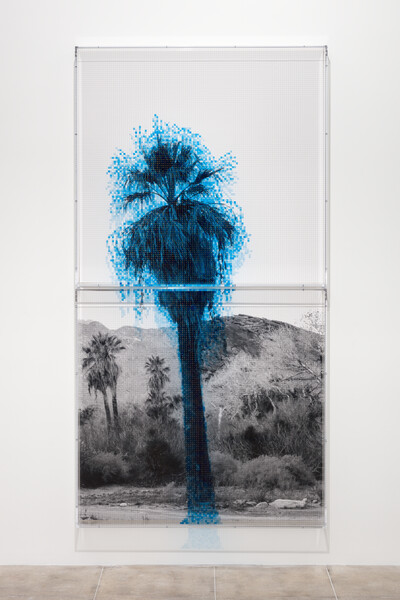
Charles Gaines
Palm Trees and Other Works
14 September - 5 January 2020
Los Angeles
Selected images
Installation views
1 / 9
Related Content
About the Artist

Charles Gaines
A pivotal figure in the field of conceptual art, Charles Gaines’ body of work engages formulas and systems that interrogate relationships between the objective and the subjective realms. Using a generative approach to create a series of works in a variety of mediums, he has built a bridge between the early conceptual artists of the 1960s and 1970s and subsequent generations of artists pushing the limits of conceptualism today.
Born in 1944 in Charleston, South Carolina, Gaines began his career as a painter, earning his M.F.A. from the School of Art and Design at the Rochester Institute of Technology in 1967. In the 1970s, Gaines’ art shifted dramatically in response to what he would later call ‘the awakening.’ Gaines’ epiphany materialized in a series called Regression (1973 – 1974), in which he explored the use of mathematical and numeric systems to create soft, numbered marks in ink on a grid, with each drawing built upon the calculations of the last. This methodical approach would carry the artist into the subsequent decades of his artistic journey.
Working both within the system and against it, Gaines points to the tensions between the empirical objective and the viewers’ subjective response. The concept of identity politics has played a central role within Gaines’ oeuvre, and the radical approach he employs addresses issues of race in ways that transcend the limits of representation.
Gaines lives and works in Los Angeles. He has been the subject of numerous exhibitions in the United States and around the world, most notably a major survey at The Institute of Contemporary Art, Miami, which traveled to the Phoenix Art Museum; a mid-career survey at the Pomona College Museum of Art and the Pitzer College Art Gallery in Claremont CA; a museum survey of early works at The Studio Museum, Harlem NY and the Hammer Museum, Los Angeles CA; and presentations at the 1975 Whitney Biennial and the Venice Biennale in 2007 and 2015. An exhibition of his work is also currently on long-term view at Dia:Beacon in New York. In 2022, Gaines launched his most ambitious public art project yet, ‘The American Manifest,’ presented by Creative Time, Governors Island and Times Square Arts. The third and final chapter of ‘The American Manifest,’ organized by Creative Time, will travel to the banks of the Ohio River in 2025. Additional forthcoming public commissions include the mural ‘Numbers and Trees: Cincinnati Cottonwoods,’ organized by Cincinnati nonprofit ArtWorks (June 2025); ‘Hanging Tree’ at Equal Justice Initiative’s Freedom Monument Sculpture Park in Montgomery AL (June 2025); and a new work for the Intuit Dome in Inglewood CA (spring 2026). Gaines will be an artist-in-residence at Hauser & Wirth Somerset in spring 2025 and a book of his collected writings will be released by Hauser & Wirth Publishers in spring 2026.
In addition to his artistic practice, Gaines was on the faculty at CalArts School of Art for over 30 years, establishing a fellowship to provide critical scholarship support for Black students in the M.F.A. Art program. He has published several essays on contemporary art, including ‘Theater of Refusal: Black Art and Mainstream Criticism’ (University of California, Irvine, 1993) and ‘The New Cosmopolitanism’ (California State University, Fullerton, 2008). In 2019, Gaines received the 60th Edward MacDowell Medal. He was inducted into the National Academy of Design’s 2020 class of National Academicians and the American Academy of Arts and Letters in May 2022. In 2023, he received an honorary doctorate from his alma mater, the Rochester Institute of Technology in New York.
Gaines’ work is included in prominent public collections such as the Museum of Modern Art, New York NY; Whitney Museum of American Art, New York NY; The Studio Museum, Harlem NY; Hirshhorn Museum and Sculpture Garden, Washington DC; Museum of Contemporary Art, Chicago IL; Hammer Museum, Los Angeles CA; Los Angeles County Museum of Art, Los Angeles CA; Museum of Contemporary Art, Los Angeles CA; San Francisco Museum of Modern Art, San Francisco CA; and Tate, London, UK.
Current Exhibitions
1 / 12



























